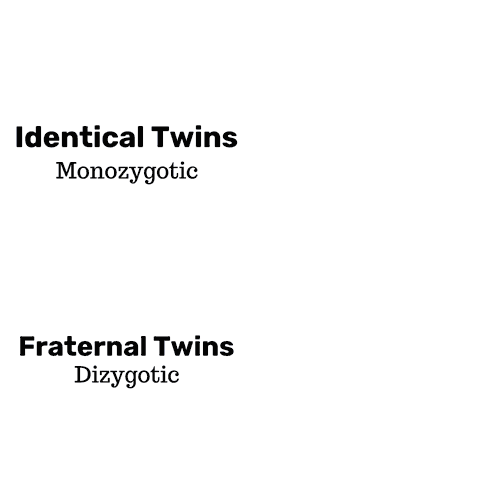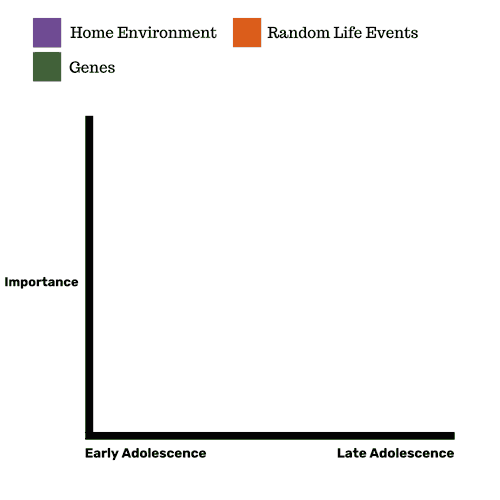Heritability
How do we figure out how important genes and environments are in developing alcohol problems?
This section will explain how scientists determine if something is genetically influenced, and how our genes interact with our environments
The key takeaway: Two study designs – twin studies and adoption studies – have provided consistent, strong evidence for the importance of genes on virtually every behavior you can imagine. But they also show that the environment is critical too.
How do we know genes are important?
Family studies
The first hint that something is influenced by our genes is when it runs in families. Family members resemble each other for all kinds of characteristics: height, hair color, temperament, and various diseases and disorders. This similarity can suggest that shared genes are influencing the outcome, but things can also run in families due to shared environment. So, at the end of the day, you can’t know for sure that something is genetic just because it runs in families.
Adoption Studies
 When parents and children are biologically related, they share both their genes and their home environments, so when they look similar, you can’t tell how much of it was shared genes and how much was shared environment. But in adoptive families, genetics and environment get split up. Adopted children (when raised by nonrelatives) share genes with parents who are not providing their home environment (their biological parents), and their environments are provided by people who didn’t give them their genetic make-up (their adoptive parents). In other words, there is a natural separation of genetic and environmental influences (as illustrated in the right part of the image). Genes from biological parents; environment from adoptive parents.
When parents and children are biologically related, they share both their genes and their home environments, so when they look similar, you can’t tell how much of it was shared genes and how much was shared environment. But in adoptive families, genetics and environment get split up. Adopted children (when raised by nonrelatives) share genes with parents who are not providing their home environment (their biological parents), and their environments are provided by people who didn’t give them their genetic make-up (their adoptive parents). In other words, there is a natural separation of genetic and environmental influences (as illustrated in the right part of the image). Genes from biological parents; environment from adoptive parents.
This means that researchers can collect data from adopted children, their biological parents, and their adoptive parents (and sometimes siblings) in order to figure out how much genetic predispositions play a role and how much the family environment matters. Do adopted children act more like their biological parents (which would imply genetic predispositions are important), or do they more closely resemble their adoptive parents (which would imply that environmental influences related to parenting are more important)? It’s a natural experiment that separates out genetic influence from parental environmental influence.
Twin Studies
Twin studies provide another powerful way to study genetic effects. Twins essentially come in two types, which are commonly called (sidenote: Technically, scientists don’t use the terms identical and fraternal twins. ‘Identical’ twins are called monozygotic (MZ) twins, mono meaning one, referring to the fact that they developed from one zygote. ‘Fraternal’ twins are technically called dizygotic (DZ) twins. These twins are so-named because they come from two (di being the Greek word for two) zygotes. Dizygotic twins result from two eggs fertilized by two sperm, just like ordinary siblings, except that fertilization happens at the same time, so they share an intrauterine environment, and hence are age matched, unlike ordinary siblings.) Because identical twins develop from a single fertilized egg, they share 100 percent of their genetic material; they have genetically identical DNA sequences. And because they are genetically identical, identical twins are always of the same sex (either both boys or both girls). Fraternal twins develop from two separate fertilized eggs, and therefore share on average 50 percent of their genetic material, just like ordinary siblings (but are age matched), and accordingly, can be of the same sex, or opposite sex.
 Twins provide a natural experiment because they are essentially two “types” of age-matched siblings who are being raised together in the same family, by the same parents, but they differ in how much of their genetic make-up they share. Scientists who do twin research often collect data from thousands of twin pairs—both identical and fraternal—and then compare how similar identical twins are to one another, as compared to how similar fraternal twins are to one another. If something is mostly determined by the home environment, then fraternal twins should be as similar to each other as identical twins are. On the other hand, if something is mostly determined by genes, then identical twins should be more similar to each other than fraternal twins are.
Twins provide a natural experiment because they are essentially two “types” of age-matched siblings who are being raised together in the same family, by the same parents, but they differ in how much of their genetic make-up they share. Scientists who do twin research often collect data from thousands of twin pairs—both identical and fraternal—and then compare how similar identical twins are to one another, as compared to how similar fraternal twins are to one another. If something is mostly determined by the home environment, then fraternal twins should be as similar to each other as identical twins are. On the other hand, if something is mostly determined by genes, then identical twins should be more similar to each other than fraternal twins are.
For example, if having a parent with alcohol use disorder causes increased alcohol problems for environmental reasons, perhaps because there are more stressors in the home or exposure to alcohol, then siblings who have parents with an alcohol use disorder should show an elevation in alcohol problems, regardless of how much genetic variation they share. In other words, if you took any two kids and put them in a home with a parent with alcohol problems, if it is mostly environmental, then they should all show an elevation in alcohol issues. Of course, (sidenote: The movie Three Identical Strangers follows the story of triplets who were separated at birth by an adoption agency and followed across development as part of a research study.), but twins provide a variation on this theme: kids being raised together with the same parents, some of whom share more of their genetic make-up with each other (identical twins) than others (fraternal twins).
Then again, if it isn’t just all environment, if a person’s genetic make-up is important in influencing how at risk they are for an alcohol use disorder (for example), then identical twins should be more similar on their alcohol outcomes than fraternal twins, because they share more similar genes. If something is entirely genetically determined, then we would expect that identical twins should be exactly alike, since they share all of their genetic code, and that fraternal twins should be half as alike, since they share only half of their genetic variation. So, to the extent that identical twins are more alike than fraternal twins for any behavior being studied, it tells us that behavior is under genetic influence.
Finally, if identical twins are not exactly alike (they rarely are for most temperamental and behavioral outcomes, which is why scientists don’t like calling them “identical” twins), it tells us that there must be other random environmental influences that impact our trait of interest. For example, one twin could experience a life stressor, such as a car accident or a romantic breakup, that the other one didn’t. Or one twin might have a different group of friends than his/her co-twin. In short, when identical twins aren’t identical for an outcome being studied, we don’t know exactly why the twins are different; we just know that there must be some kind of environmental influences at play that are making them different, since genetically they are identical.
There have now been thousands of twin and adoption studies carried out, on virtually every behavior you can imagine. These studies have been carried out by researchers around the world.
The overarching conclusion from all those studies is that virtually everything is under genetic influence. Identical twins are almost always more similar than fraternal twins (who share just half of their genetic code), despite both siblings being raised in the same family, by the same parents.
What do heritability estimates mean?
Scientists like to talk about “how heritable” different outcomes are – meaning how much they are influenced by genes. Heritability gives an indication of the relative importance of genetic effects on an outcome. For example, alcohol and other substance use disorders have a heritability of 50-70%.
An important thing to remember is that heritability is specific to a population, not a person. What that means is that alcohol use disorder being 50% heritable does NOT mean that 50% of the reason a person developed problems was because of their genes and 50% was because of their environment. For any person, complex life outcomes are always influenced by their genes and environments. A heritability of 50% means that about half of the differences between people are due to differences in their DNA, and about half is due to differences in their environment. Why would we care about a population statistic?
 Imagine that you are trying to figure out the area of a rectangle. For any rectangle, the area is always a product of its length and width. But when looking at a group of rectangles, you can ask how much length or width contributes to differences in their area. For example, in the figure, the first group of rectangles differ in area because they all have different lengths. The second group of rectangles all differ in area because of their different widths.
Imagine that you are trying to figure out the area of a rectangle. For any rectangle, the area is always a product of its length and width. But when looking at a group of rectangles, you can ask how much length or width contributes to differences in their area. For example, in the figure, the first group of rectangles differ in area because they all have different lengths. The second group of rectangles all differ in area because of their different widths.
There is a direct parallel to thinking about the importance of genes and environments. For any one person, our outcomes are always a product of both. But we can ask whether differences between people (e.g., why some people drink more or are more depressed) is more strongly related to differences in their DNA or in their environments. Heritability tells us how much of the differences between people is due to differences in their DNA.
If a behavior is influenced by our genes, what role does the environment play?
How the importance of genes and environments changes across development
 The importance of genetic influences can change across time, and it also changes across development. When a baby is developing, certain genes “turn on” to code for the development of fingers and toes and eyes and ears, and (over a much longer period) our brains. With alcohol use, it’s a bit more complex; we know that the more individuals drink, the more important genetic influences become. In other words, once people start using alcohol, individuals who carry more genetic risk are more likely to develop problems. When adolescents start drinking is mostly influenced by the environment – because you need access to alcohol before your genes can get activated, so aspects of the home and neighborhood that impact access are most important. But once an individual starts drinking, whether or not they carry risk-enhancing genes becomes increasingly important in how much they drink. The figure illustrates this effect using data from a national study of twins. Over time, the heritability of alcohol use increases, meaning more of the differences between how much people drink is due to differences in their DNA. This means that one of the ways parents can help protect their children is by reducing access to alcohol so those risk-enhancing genes are not activated at a young age when the brain is still rapidly developing.
The importance of genetic influences can change across time, and it also changes across development. When a baby is developing, certain genes “turn on” to code for the development of fingers and toes and eyes and ears, and (over a much longer period) our brains. With alcohol use, it’s a bit more complex; we know that the more individuals drink, the more important genetic influences become. In other words, once people start using alcohol, individuals who carry more genetic risk are more likely to develop problems. When adolescents start drinking is mostly influenced by the environment – because you need access to alcohol before your genes can get activated, so aspects of the home and neighborhood that impact access are most important. But once an individual starts drinking, whether or not they carry risk-enhancing genes becomes increasingly important in how much they drink. The figure illustrates this effect using data from a national study of twins. Over time, the heritability of alcohol use increases, meaning more of the differences between how much people drink is due to differences in their DNA. This means that one of the ways parents can help protect their children is by reducing access to alcohol so those risk-enhancing genes are not activated at a young age when the brain is still rapidly developing.
How our genes and environments work together
Just because something is influenced by our genes doesn’t mean that the environment isn’t important too. In fact, the environment can change the likelihood of an outcome, even if a person is carrying risk-enhancing genes.
In the case of alcohol use, you can imagine that if there was no alcohol available, it wouldn’t matter what genes you carry, you are never going to develop problems. That’s an extreme, but any environment that reduces access to alcohol can actually reduce how important genetic influences are. Learn more about how this works in the Genes and Environment section.
Learn more about how genes influence behavior here: The Three Laws of Behavior Genetics
Data for the graph showing changes across development comes from Gene-Environment Interaction in Patterns of Adolescent Drinking: Regional Residency Moderates Longitudinal Influences on Alcohol Use. Richard J. Rose, Danielle M. Dick, Richard J. Viken, and Jaakko Kaprio. Alcoholism: Clinical and Experimental Research, May 2001.